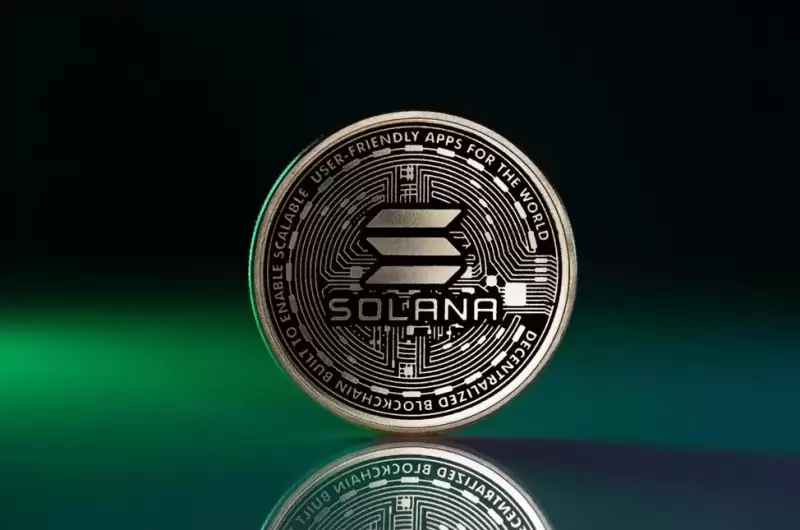 |
|
 |
|
 |
|
 |
|
 |
|
 |
|
 |
|
 |
|
 |
|
 |
|
 |
|
 |
|
 |
|
 |
|
 |
|
2025年4月の時点で、財団はポリシーを実装しました。このポリシーでは、新しいバリデーターがその代表団プログラム(SFDP)に追加されたすべてのポリシーを実施しました。

Solana Foundation has adjusted its validator strategy to promote network decentralization and reduce reliance on its support. As of April 2025, the Foundation introduced a policy where, for every new validator added to its Delegation Program (SFDP), three existing validators are removed if they meet specific criteria.
Solana Foundationは、ネットワークの分散化を促進し、そのサポートへの依存を促進するために、バリデーター戦略を調整しました。 2025年4月の時点で、財団はポリシーを導入しました。このポリシーでは、委任プログラム(SFDP)に追加されたすべての新しいバリデーターについて、特定の基準を満たしている場合、3つの既存の有効化者が削除されます。
This policy, which began with the addition of Blockfolio to the SFDP, will see three existing validators removed. The departing validators are NodeReal, CCVC, and STiC Pay, leaving the SFDP with 15 validators.
このポリシーは、SFDPにブロックフォリオを追加することから始まり、3つの既存のバリデーターが削除されます。出発するバリデーターは、Nodereal、CCVC、およびSTIC Payであり、SFDPに15のバリデーターを残します。
To be removed from the program, validators must have been in the SFDP for over 18 months and have less than 1,000 SOL in external stake. Moreover, they must not be a Node as they transition out of the program.
プログラムから削除するには、バリデーターは18か月以上SFDPに属し、外部株式に1,000個未満のSOLを持っている必要があります。さらに、プログラムから移行するため、ノードであってはなりません。
This move aims to encourage validators to attract independent stake and operate self-sufficiently. Concerns have been raised about many validators, in some cases up to 90-100% of their stake, relying heavily on Foundation backing.
この動きは、バリデーターが独立した利害関係を引き付け、自立して運営することを奨励することを目的としています。多くのバリデーター、場合によっては株式の最大90〜100%までの懸念が提起されており、基礎の支援に大きく依存しています。
Research from Helius indicates that over half of Solana’s validators could become unprofitable without this support, highlighting the challenge of high on-chain governance costs. At present, smaller validators may struggle to maintain profitability and attract independent stake, potentially leading to consolidation or exits.
ヘリウスの調査によると、ソラナのバリデーターの半分以上がこのサポートなしでは不採算になり、高い鎖ガバナンスコストの課題を強調しています。現在、小規模なバリデーターは、収益性を維持し、独立した利害関係を引き付けるのに苦労する可能性があり、潜在的に統合または出口につながる可能性があります。
The policy is part of a broader effort to improve the Nakamoto Coefficient, a measure of decentralization, by reducing stake concentration. However, the Foundation has not yet responded to ongoing discussions about the policy’s impact.
このポリシーは、利害関係の集中を削減することにより、分散化の尺度である中本係数を改善するためのより広範な取り組みの一部です。ただし、財団は、ポリシーの影響に関する継続的な議論にまだ対応していません。
By prioritizing validators with independent stake and phasing out those overly reliant on Foundation support, the policy aims to improve the Nakomoti Coefficient, reducing the risk of centralized control and enhancing network resilience.
独立した利害関係者を優先し、財団のサポートに過度に依存している人々を段階的に段階的に廃止することにより、このポリシーはナコモティ係数を改善し、集中制御のリスクを減らし、ネットワークの回復力を強化することを目的としています。
Smaller validators, defined as those with less than 1,000 SOL in external stake, will be removed from the program after 18 months, which could render many unprofitable.
外部ステークで1,000個未満のSOLを持つものとして定義されている小さなバリデーターは、18か月後にプログラムから削除され、多くの不採算を行う可能性があります。
With over half of validators potentially unviable without Foundation backing, according to Helius data, smaller validators may struggle to attract independent stake, leading to consolidation or exits.
ヘリウスのデータによると、財団の支援なしで潜在的に実行不可能なバリデーターの半分以上が、小さなバリデーターは独立した株式を引き付けるのに苦労し、統合または出口につながる可能性があります。
This policy change is part of a broader shift in cryptocurrency toward on-chain governance, where token holders vote on network policies and upgrades.
このポリシーの変更は、トークン保有者がネットワークポリシーとアップグレードに投票するチェーンガバナンスに対する暗号通貨のより広範な変化の一部です。
Cardano introduced on-chain governance with the Chang hard fork in September 2024, establishing a model with separate governance branches, a legislative body, and a constitutional committee. ADA holders can delegate voting power to Delegate Representatives (DReps), who influence network decisions, including validator (stake pool) policies.
Cardanoは、2024年9月にChang Hard Forkでチェーンガバナンスを導入し、個別のガバナンス支店、立法機関、憲法委員会を備えたモデルを確立しました。 ADA保有者は、Validator(Stake Pool)ポリシーを含むネットワークの決定に影響を与える代表者(DREP)を委任するために投票権を委任できます。
Cardano’s stake pools are community-operated, with rewards tied to delegation from ADA holders. The governance model encourages decentralization by allowing token holders to choose stake pools, reducing reliance on centralized entities.
カルダノのステークプールはコミュニティ操作であり、ADA所有者からの代表団に報酬が結び付けられています。ガバナンスモデルは、トークンホルダーがステークプールを選択できるようにし、集中型エンティティへの依存を減らすことにより、地方分権化を奨励しています。
Unlike Solana’s Foundation-driven staking, Cardano’s approach empowers the community to incentivize validators through delegation, fostering a competitive validator ecosystem.
Solanaの基礎主導のステーキングとは異なり、Cardanoのアプローチは、委任を通じてバリデーターを奨励し、競争力のあるバリデーターエコシステムを促進するためのコミュニティに権限を与えます。
This democratic model enhances decentralization but risks low voter turnout, potentially concentrating influence among active DReps or large ADA holders. Compared to Solana, Cardano’s governance is less centralized, as it lacks a foundation dictating validator inclusion, but it faces challenges in ensuring broad participation.
この民主的なモデルは地方分権化を促進しますが、有権者の投票率が低く、積極的なDREPまたは大規模なADA保有者の間で影響力を集中させる可能性があります。ソラナと比較して、カルダノのガバナンスは、検証装置の包含を決定する基盤が欠けているため、あまり集中化されていませんが、幅広い参加を確保する際の課題に直面しています。
Polkadot’s OpenGov model, implemented in 2023, uses on-chain governance where proposals are written in code, voted on transparently, and executed automatically upon approval. Token holders vote on network upgrades and validator policies, increasing trust through deterministic processes.
2023年に実装されたPolkadotのOpenGovモデルは、提案がコードで書かれ、透過的に投票され、承認時に自動的に実行されるオンチェーンガバナンスを使用します。トークンホルダーは、ネットワークのアップグレードとバリデーターポリシーに投票し、決定論的プロセスを通じて信頼を高めます。
Validators in Polkadot are selected based on stake and performance, with nominators (token holders) choosing validators to back. The system incentivizes validators to attract independent stake, similar to Solana’s push for self-sufficiency. However, Polkadot’s governance is fully on-chain, contrasting with Solana’s off-chain Foundation-led decisions.
Polkadotのバリデーターは、利害関係とパフォーマンスに基づいて選択され、ノミネーター(トークンホルダー)がバックレーターを選択します。このシステムは、Solanaが自給自足を求めていると同様に、独立した利害関係を引き付けるために、Validatorsを奨励します。しかし、ポルカドットのガバナンスは完全にチェーンであり、ソラナのオフチェーン財団主導の決定とは対照的です。
Polkadot’s transparent, community-driven model reduces centralized control compared to Solana’s Foundation policy. However, it requires active community participation, and “whale” token holders could dominate voting, mirroring Solana’s concern about stake concentration. Polkadot’s approach offers a more decentralized alternative but demands robust engagement to avoid governance capture.
Polkadotの透明でコミュニティ主導のモデルは、Solanaの基礎政策と比較して集中制御を減らします。ただし、積極的なコミュニティへの参加が必要であり、「クジラ」のトークンホルダーは投票を支配し、Solanaの利害関係に関する懸念を反映しています。 Polkadotのアプローチは、より分散化された代替品を提供しますが、ガバナンスのキャプチャを避けるために堅牢なエンゲージメントを要求します。
Ethereum relies on off-chain governance through Ethereum Improvement Proposals (EIPs), discussed in forums, conferences, and GitHub. Core developers, node operators, and miners (pre-Merge) or validators (post-Merge) reach consensus informally, with no formal on-chain voting.
Ethereumは、フォーラム、会議、Githubで議論されているEthereum改善提案(EIP)を通じて、オフチェーンガバナンスに依存しています。コア開発者、ノードオペレーター、マイナー(事前マージ)またはバリデーター(登録後)は、正式なオンチェーン投票なしで非公式にコンセンサスに達します。
Since transitioning to Proof-of-Stake in 2022, Ethereum’s validators stake 32 ETH to participate, with rewards tied to performance. Unlike Solana’s Foundation staking, Ethereum has no central entity allocating stake; validators compete for community-driven delegation.
2022年に証明のステークに移行して以来、EthereumのValidatorsは32 ETHを獲得して参加し、報酬はパフォーマンスに結び付けられています。ソラナの財団のステーキングとは異なり、イーサリアムには株式を割り当てる中央の実体はありません。バリデーターは、コミュニティ主導の代表団を競います。
The ecosystem encourages decentralization through protocols like Lido, though concerns persist about Lido’s dominance (controlling ~30% of staked ETH). Ethereum’s decentralized validator model avoids Solana’s centralized Foundation control but faces risks of stake concentration in large staking pools. Its off-chain governance allows flexibility but can be slow and contentious, as
エコシステムは、Lidoのようなプロトコルを通じて地方分権化を奨励していますが、Lidoの優位性についての懸念は存続しています(染色されたETHの30%をコントロールしています)。 Ethereumの分散化された検証装置モデルは、Solanaの集中財団制御を回避しますが、大きなステーキングプールでの利害関係の集中のリスクに直面しています。そのオフチェーンガバナンスは柔軟性を可能にしますが、ゆっくりと論争的である可能性があります。
免責事項:info@kdj.com
提供される情報は取引に関するアドバイスではありません。 kdj.com は、この記事で提供される情報に基づいて行われた投資に対して一切の責任を負いません。暗号通貨は変動性が高いため、十分な調査を行った上で慎重に投資することを強くお勧めします。
このウェブサイトで使用されているコンテンツが著作権を侵害していると思われる場合は、直ちに当社 (info@kdj.com) までご連絡ください。速やかに削除させていただきます。





















































